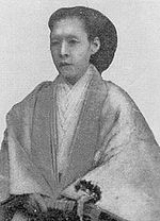
Nakayama Yoshiko
Encyclopedia
was a Japanese
lady-in-waiting
in the court of the Imperial House of Japan
. She was a concubine of Emperor Kōmei
and the mother of Emperor Meiji
.
) and a member of the Fujiwara family
. Her mother was the 11th daughter of the daimyo
of Matsuura Domain, Matsuura Seizan
. She was born in Kyoto
and entered service of the court at the age of 17. She became a concubine of Emperor Komei, and on 3, November, 1852, gave birth to Mutsuhito, later known as Emperor Meiji
, at her father’s residence outside of the Kyoto Imperial Palace. She returned with her son to the Palace five years later. Her son was the eldest of six born to Emperor Komei. After the Meiji Restoration
, she relocated to the new capital to Tokyo
in 1870 at the behest of the Emperor. She is buried in Toshimagaoka cemetery in Bunkyo, Tokyo
.
Japanese people
The are an ethnic group originating in the Japanese archipelago and are the predominant ethnic group of Japan. Worldwide, approximately 130 million people are of Japanese descent; of these, approximately 127 million are residents of Japan. People of Japanese ancestry who live in other countries...
lady-in-waiting
Lady-in-waiting
A lady-in-waiting is a female personal assistant at a royal court, attending on a queen, a princess, or a high-ranking noblewoman. Historically, in Europe a lady-in-waiting was often a noblewoman from a family highly thought of in good society, but was of lower rank than the woman on whom she...
in the court of the Imperial House of Japan
Imperial House of Japan
The , also referred to as the Imperial Family or the Yamato Dynasty, comprises those members of the extended family of the reigning Emperor of Japan who undertake official and public duties. Under the present Constitution of Japan, the emperor is the symbol of the state and unity of the people...
. She was a concubine of Emperor Kōmei
Emperor Komei
was the 121st emperor of Japan, according to the traditional order of succession. Kōmei's reign spanned the years from 1846 through 1867.-Genealogy:Before Kōmei's accession to the Chrysanthemum Throne, his personal name was ;, his title was ....
and the mother of Emperor Meiji
Emperor Meiji
The or was the 122nd emperor of Japan according to the traditional order of succession, reigning from 3 February 1867 until his death...
.
Biography
Nakayama Yoshiko was the daughter of Lord Nakayama Tadayasu, Minister of the Left (SadaijinSadaijin
, most commonly translated as "Minister of the Left", was a government position in Japan in the late Nara and Heian periods. The position was consolidated in the Taihō Code of 702. The Asuka Kiyomihara Code of 689 marks the initial appearance of the Sadaijin in the context of a central...
) and a member of the Fujiwara family
Fujiwara family
The Fujiwara clan , descending from the Nakatomi clan, was a powerful family of regents in Japan.The clan originated when the founder, Nakatomi no Kamatari , was rewarded by Emperor Tenji with the honorific "Fujiwara", which evolved as a surname for Kamatari and his descendants...
. Her mother was the 11th daughter of the daimyo
Daimyo
is a generic term referring to the powerful territorial lords in pre-modern Japan who ruled most of the country from their vast, hereditary land holdings...
of Matsuura Domain, Matsuura Seizan
Matsuura Seizan
, born a famed swordsman during the Edo period of Japan. Seizan was a practitioner of Iba Hideaki's Shingyōtō-ryū school of swordsmanship, in which Seizan was considered as an adept. Seizan adopted the name Joseishi after receiving the final transmission of the Shingyōtō ryu school...
. She was born in Kyoto
Kyoto
is a city in the central part of the island of Honshū, Japan. It has a population close to 1.5 million. Formerly the imperial capital of Japan, it is now the capital of Kyoto Prefecture, as well as a major part of the Osaka-Kobe-Kyoto metropolitan area.-History:...
and entered service of the court at the age of 17. She became a concubine of Emperor Komei, and on 3, November, 1852, gave birth to Mutsuhito, later known as Emperor Meiji
Emperor Meiji
The or was the 122nd emperor of Japan according to the traditional order of succession, reigning from 3 February 1867 until his death...
, at her father’s residence outside of the Kyoto Imperial Palace. She returned with her son to the Palace five years later. Her son was the eldest of six born to Emperor Komei. After the Meiji Restoration
Meiji Restoration
The , also known as the Meiji Ishin, Revolution, Reform or Renewal, was a chain of events that restored imperial rule to Japan in 1868...
, she relocated to the new capital to Tokyo
Tokyo
, ; officially , is one of the 47 prefectures of Japan. Tokyo is the capital of Japan, the center of the Greater Tokyo Area, and the largest metropolitan area of Japan. It is the seat of the Japanese government and the Imperial Palace, and the home of the Japanese Imperial Family...
in 1870 at the behest of the Emperor. She is buried in Toshimagaoka cemetery in Bunkyo, Tokyo
Bunkyo, Tokyo
is one of the 23 special wards of Tokyo, Japan. Situated in the middle of the ward area, Bunkyō is a residential and educational center. Beginning in the Meiji period, literati like Natsume Sōseki, as well as scholars and politicians have lived there...
.

